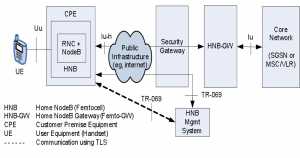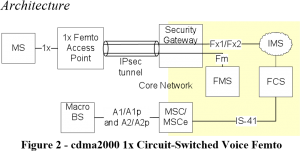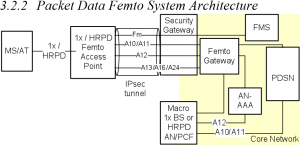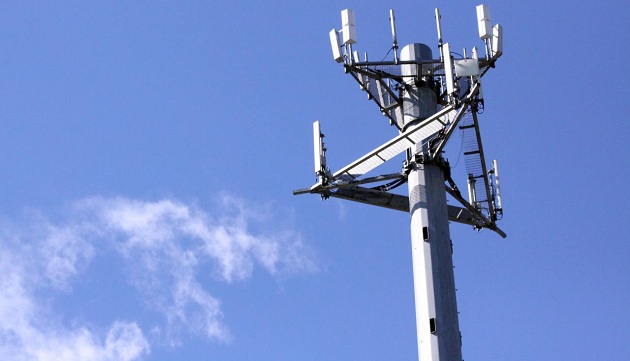Femtocells are small, user-installed base stations that enhance coverage for in-building cellular services. The new paradigm introduced by femtocells also brings unique challenges, namely i) unplanned deployment, ii) user-installation, iii) restricted access, and iv) inter-operability with existing handsets and infrastructure. This paper describes the impact of these challenges on different deployment aspects such as interference management, mobility management, and self-configuration. Potential solutions to address the challenges are subsequently discussed. In addition, the standardized femtocell architectures for the UMTS and CDMA2000 families of access technologies are introduced and compared.
Introduction
Femtocells are personal miniature base stations installed on the subscriber’s premises for providing cellular service within the home or enterprise environment. Typically femtocells are connected to the Internet and the cellular operator’s network via a DSL router or cable modem. Access to a femtocell can be open to any subscriber, restricted to a limited set of users, or a combination of both with priority for preferred users.
Femtocells offer benefits for both subscribers and operators. The subscriber experiences better voice service coverage and higher data throughput. Special service plans can provide additional incentives for home use (e.g., free calls from home). The operator is able to off-load traffic from the macro cellular network, thus reducing infrastructure cost. Moreover, indoor coverage problems can be resolved without deploying expensive macro base stations. Operators also have an interest in ensuring their mobile devices are used in the home despite the availability of competing technologies (e.g. Wi-Fi). Such “stickiness” with their features and services helps reducing churn. Finally, it supports a transition from wire line service to exclusive use of wireless devices at home.
Recognizing these benefits Verizon and Sprint have launched Femtocell products nationwide in the U.S. in recent months. Several operators in Europe have been conducting trials with femtocells. Operators, vendors, content providers and innovative start-ups founded the Femto Forum, a membership organization to promote femtocell deployments worldwide. A considerable list of OEMs offer solutions in this growing industry, including AlcatelLucent, Huawei, ZTE, ip.Access, Airvana, and Samsung, to name a few. Qualcomm announced the development of a Femtocell Station Modem (FSM) in February this year. It will support HSPA+ and CDMA2000, including 1X and EV-DO Rev. A and Rev. B. The chipsets will include baseband functions, network listen and integrated RF capabilities for all major wireless bands.
Network Architecture
Femtocells are envisaged to be deployed in large numbers by home and enterprise users at their premises. This new unplanned term is not standardized in 3GPP2 deployment model requires a network architecture which meets the following requirements:
- Scalable to a large number of femtocells with minimal or no impact to the existing infrastructure
- Secure and reliable connectivity from femtocell to the operator’s core network via the Internet
- Remotely configurable
These properties form the basis of the standardized femtocell system architectures in both 3GPP and 3GPP2 which are described in the following subsections.
3GPP Femtocell Network Architecture
Figure 1 illustrates 3GPP femtocell architecture described in this section.

HNB supports NodeB and RNC-like functions. It connects to the handsets (UEs) via existing Uu interface and to the HNB-GW via new Iu-h interface. It is typically owned by the end user.
HNB-GW concentrates HNB connections (many-to-one relationship between HNBs and HNB-GW) and presents itself as a single RNC to the core network (CN) using the existing Iu interface. This allows for scaling to large numbers of HNBs, and avoids new interfaces and HNB-specific functions at the CN.
Home Management System (HMS) is used for provisioning HNB configuration data remotely using the TR-069 family of standards. TR-069 is traditionally used for DSL modem configuration.
Security Gateway (SeGW) uses IPSec to provide a secure link between the HNB and the HNB-GW (over Iu-h) and between the HNB and the HMS. These links can either use the same or different SeGWs. The SeGW is also responsible for HNB authentication.
3GPP2 Femtocell Network Architecture
This section describes two architectures for femto systems as specified by 3GPP2.
1.1.1 1x Circuit-Switched Voice Femto System Architecture
Figure 2 shows the architecture for supporting circuit-switched (CS) voice service via a femtocell.
Femto access point (FAP) has equivalent functions to a Base Station (BS) in the macro network, e.g., communicating with the handset (MS) and setting up a voice circuit with the CN.
Femto Convergence Server (FCS) provides equivalent functions to an MSC in the macro network, e.g., providing processing and control for calls and services. However, 1x CS FAP and FCS do not communicate using the legacy BS-MSC interface. Instead, Fx1 and Fx2 interfaces which are based on the IP Multimedia Subsystem (IMS) framework are used. From the perspective of a macro MSC, the FCS appears as another MSC and supports the IS-41 interface for inter-MSC communication.
Femto Management System (FMS) is used for remotely configuring the FAP via the Fm interface. Like in the 3GPP architecture, this OA&M interface is based on TR-069.
Security Gateway (SeGW) provides secure communication between the FAP and the operator’s core network. IP packets between FAP and CN are encapsulated in an IPSec tunnel. As a security gateway the FGW is also responsible for authenticating and authorizing the FAP.
Figure 3 – cdma2000 1x and HRPD Packet Data Femto Architecture

Figure 3 shows the 3GPP2 architecture supporting packet data services through either 1x or HRPD (also known as EV-DO) air-interfaces. In case the FAP supports both 1x CS and 1x/HRPD packet data, common entities (i.e., FGW and FMS) and interfaces (i.e., IPSec tunnel and Fm interface) will be used.
FAP provides functions equivalent to an HRPD access network (AN) or a 1x BS.
Femto Gateway (FGW) provides proxy function support for HRPD AN interfaces such as A11, A12, A13, A16, and A24 interfaces. This allows the FAP to transfer an air-interface session to and from the macro AN in both idle and active states for seamless handoff. It also supports paging of an AT from the macro AN to the FAP. The use of FGW is optional in the standard.
PDSN routes MS/AT originated or MS/AT terminated packet data traffic and establishes, maintains, and terminates link layer sessions to ATs. For seamless IP mobility, the FAP should connect to the same PDSN as the macro AN or BS in the area. Since the FAP reuses A10/A11 interfaces which are identical to interfaces used by a macro AN/BS, the FAP appears as just another AN/BS from the perspective of the PDSN.
AN-AAA (AN Authentication, Authorization and Accounting) server is responsible for authenticating and authorizing ATs via A12 interface for both macro AN and FAP.
Interference Management
Since RF coverage of femtocells are not manually optimized by the cellular operator and deployment is generally ad hoc, RF interference issues may arise unless appropriate methods are utilized. Furthermore due to limited spectrum available to operators macrocells and femtocells can share at least one frequency in order to increase efficiency of spectrum use.
To achieve the desired performance, the following interference and mobility management methods need to be employed as part of the femtocell design. These methods constitute the baseline recipe for femtocell interference and mobility management. They reduce the outage probability, improve voice and data performance, and enable robust system operation by adapting to the particular RF conditions of each femtocell.
1.1.2 Femtocell DL Tx Power Self Calibration
As femtocells create desired coverage in the home area, coverage holes may be created around the home for other (non-associated) mobiles. Thus each femtocell’s transmit power needs to be adjusted carefully depending on the particular femto location in a macrocell (e.g., cell edge vs. cell site) and deployment scenario (suburban vs. urban). This can be achieved via autonomous self calibration where femtocells make DL measurements from macrocells and other femtocells, and then calculate the required transmit power levels.
1.1.3 Carrier Allocation to Femtocells and Interfrequency Handover for Macrocell Users
For efficient use of available frequency spectrum it is desirable that femtocells share some of the carriers with the macrocell. Thus, although femtocell power calibration limits the coverage holes, macrocell users on the same carrier passing by the femtocell residence may still experience an outage (e.g., if the femtocell is located near a window). In such cases, macrocell handsets need to perform inter-frequency handover to another macro carrier to avoid the femtocell coverage hole. Only few carriers should be allocated to femtocells so that high mobility macrocell users do not perform very frequent inter-frequency handovers. On the other side, if there is strong inter-femto interference, it is desirable to assign neighboring femtocells on different carriers. As a compromise, an autonomous femtocell carrier allocation algorithm is recommended for femtocells where femtocells have a preferred carrier and they choose another carrier (within the allowed carrier set) only when strong interference is detected on the preferred carrier. Significant performance gains can be achieved with multiple carrier deployments with proper inter-frequency handover mechanisms. Mobility simulations show some potential impact on handset battery life with legacy handover methods. Also for 3GPP2 femtocells, a reduction in adjacent channel interference is desirable.
1.1.4 Mobility Support and Management for Femtocell Users (Beacon Tx)
When a femtocell handset arrives at home, it is usually desirable for the handset to camp on the femtocell (e.g., to offload traffic from macrocells or to offer “free in-home minutes”). This applies even if the femtocell does not offer better signal quality than the macrocell or even if the handset is operating on a different carrier on the macrocell compared to the femtocell carrier. Typically, the handset searches for other frequencies only when the current macro carrier is weak. In 3GPP systems, cell reselection parameters should be adjusted to enable a mobile user to detect its own femtocell operating on a different carrier. In 3GPP2 systems, beacons can be radiated by femtocells to re-direct the handset to the femto carrier frequency. The power and periodicity of the beacon needs to be adjusted properly not only to reduce interference to non-associated mobiles (e.g., in vicinity of a home) but also to minimize delay in femtocell discovery for handsets entering the femtocell coverage.
1.1.5 Adaptive Attenuation on UL and Limiting Handset Tx Power
Handsets in the proximity of femtocells can create very high signal levels (compared to thermal noise floor) at the femtocells and result in significant UL performance degradation and instability. One particularly bad scenario occurs when a restricted handset close to a femtocell is transmitting bursty UL data to a neighbor femtocell or a macrocell. To provide robust operation under such conditions an adaptive UL attenuation algorithm needs to be used. Additional UL attenuation is applied at the femtocell whenever strong UL interference is present.
What’s Next?
The issues and solutions discussed in Section 4 focus on immediate topics related to femtos. This section introduces a few areas which provide additional benefits, especially as femtocells become more prevalent.
Roaming Support: Offering wireless access through femtocells to subscribers of a different network provider extends the usefulness of femtos. This feature is useful for all femtocell access modes (open, closed, and hybrid). The challenge lies in accessing the correct HLR in the context of legacy systems and correctly maintaining its subscription list.
Temporary Membership: Certain scenarios (e.g. wireless service at a hotel) call for a temporary membership in a closed subscriber group. A desirable solution for this feature avoids frequent messaging to maintain subscription lists and ensures reliable removal of the subscriber while in or out of service.
Local IP Access: With this new type of service, servers local to the femtocell can be accessed without routing the traffic through the operator’s network. Thus, e.g., a media server, nanny cam, or home automation controller can be accessed directly from the handset. Similarly, it enables direct access to the Internet through an ISP while bypassing the CN. Solutions for this feature have been designed, though the mobility aspect and some regulatory hurdles remain for further study.
Remote Access: Analogous to the Local IP Access described above, remote access allows servers in the home network to be accessed by a handset in the macro network or in another femto. The security concepts need to be extended to provide adequate protection.
Enterprise Features: Femtocells provide attractive solutions for enterprise and hotspot environments. Closed subscriber groups on a corporate campus or a vacation resort might replace the wire line PBX and allow for a more cost-effective mobility solution. Satisfactory service depends on the introduction of features such as seamless handover from femtocell to femtocell, subscriptions limited to the enterprise area, and tailored OA&M functionality.
Conclusions
We introduced the concept of femtocells and reviewed how 3GPP and 3GPP2 solved the architectural challenges. While the solutions are similar between the two technologies, there are a few distinct differences due to the existing architecture in the 3GPP and 3GPP2 network.
While femtocells introduce a number of difficult challenges, there appear to be good solutions available to address these. Interference management techniques provide sufficient protection even in the unplanned deployment scenario used for femtocells. For existing handsets, most solutions for femtocell restricted access control have some drawbacks but provide adequate performance. Though, only new femto-aware handsets enable the full gain provided by femtocells.
One of the more difficult problems lies in identifying the correct femtocell in a handover scenario. Changes to the existing macro network are likely required to arrive at an efficient, reliable solution. The use of unprotected, public resources on the backhaul, namely a DSL or cable modem connection, introduces challenges related to Security, QoS, and bandwidth efficiency. Solutions in all these areas are available, even though some of them might still need to be standardized. Femtocell self configuration is the solution to the subscriber-based deployment model. For effective self-configuration, a network listen function is required.
Femtocells are being deployed in various markets while the standardization is still progressing. There are several technical areas which require further study
as outlined in Section 5. Nevertheless, when fully deployed, femtocells will result in orders of magnitude increase in area spectral efficiency, thus maximizing the return on expensive 3G licensed spectrum.

